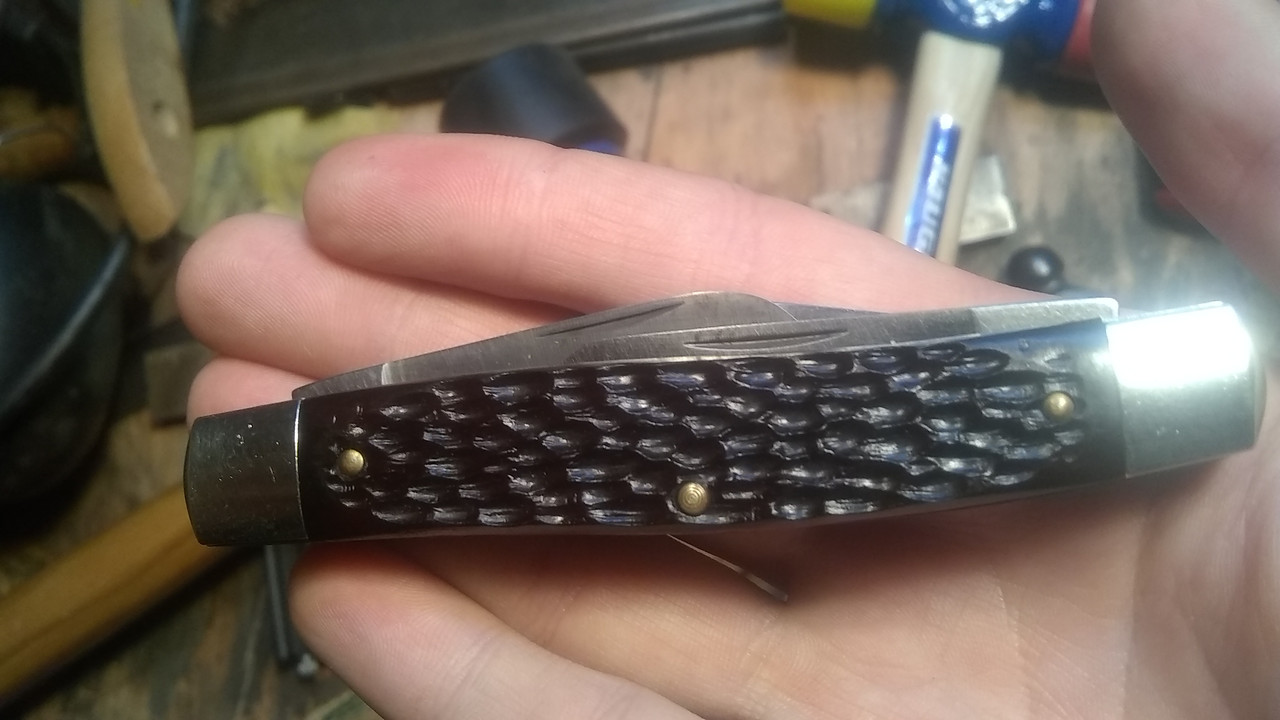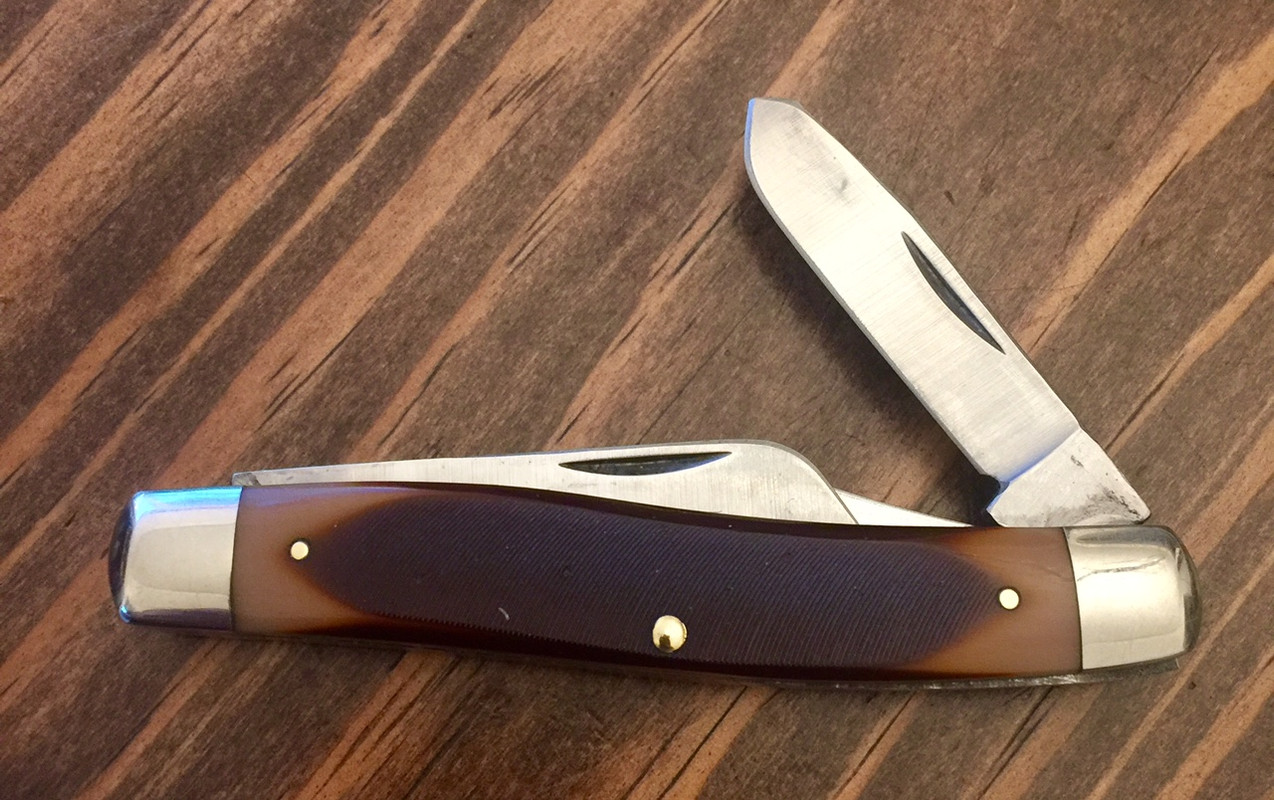-
The BladeForums.com 2024 Traditional Knife is available! Price is $250 ea (shipped within CONUS).
Order here: https://www.bladeforums.com/help/2024-traditional/
You are using an out of date browser. It may not display this or other websites correctly.
You should upgrade or use an alternative browser.
You should upgrade or use an alternative browser.
Humpback spey blades, why ?
- Thread starter Hickory n steel
- Start date
Hickory n steel
Gold Member
- Joined
- Feb 11, 2016
- Messages
- 20,735
Now that ones very slight.
I remember my 34OT being much more prominent.
Hickory n steel
Gold Member
- Joined
- Feb 11, 2016
- Messages
- 20,735
That ones definitely not much, but I guess I'm just a bit obsessive over little details sometimes because it sure catches my eye right away.If that's what you guys are calling a humpback spey blade, no wonder I didn't know what everyone was talking about! I'd have never noticed that "hump" on the spey blade of the OTJohnDF just posted!
- GT
waynorth
Dealer / Materials Provider
- Joined
- Nov 19, 2005
- Messages
- 33,346
I have looked at some with "humps!!" The protrusion it affords might make it easier to grab the right blade in an admitted "stressful situation!!"
Speying is a stressful time!!
Maybe someone who actually performs this "operation" could chime in!!
Speying is a stressful time!!
Maybe someone who actually performs this "operation" could chime in!!
r8shell
Knifemaker / Craftsman / Service Provider
- Joined
- Jan 16, 2010
- Messages
- 25,908
It could have a practical function. Or it's just neat looking.I have looked at some with "humps!!" The protrusion it affords might make it easier to grab the right blade in an admitted "stressful situation!!"
Speying is a stressful time!!
Maybe someone who actually performs this "operation" could chime in!!

yablanowitz
Platinum Member
- Joined
- Apr 14, 2006
- Messages
- 10,021
Looking at the examples I have with the blades closed, it appears to be done to clear the nail nick on the sheepsfoot behind it.
Hickory n steel
Gold Member
- Joined
- Feb 11, 2016
- Messages
- 20,735
I can see on some it would allow for an accessable nail nick without the whole spine having to really stick up high, but then they could just very the placement of the blade and nick for optimal accessibility.It could have a practical function. Or it's just neat looking.

Maybe they just don't want to rearrange the blades from what people are used to ?
Hickory n steel
Gold Member
- Joined
- Feb 11, 2016
- Messages
- 20,735
I always assumed nail nick access was a good suspect, but also wonder why not just rearrange the blades.Looking at the examples I have with the blades closed, it appears to be done to clear the nail nick on the sheepsfoot behind it.
I'm sure the standard stockman configuration exists as it does for a reason though.
yablanowitz
Platinum Member
- Joined
- Apr 14, 2006
- Messages
- 10,021
It only seems to be needed on knives where the sheepsfoot sits fairly low in the frame. When it sits with the tip proud of the frame, they leave the spine of the spey straight.I always assumed nail nick access was a good suspect, but also wonder why not just rearrange the blades.
I'm sure the standard stockman configuration exists as it does for a reason though.
Hickory n steel
Gold Member
- Joined
- Feb 11, 2016
- Messages
- 20,735
I guess they really must've gotten this Ranger just right then, because the sheep's foot is almost flush with the clip, it's tip does not stick up, and the straight back spey sits at about the perfect height.It only seems to be needed on knives where the sheepsfoot sits fairly low in the frame. When it sits with the tip proud of the frame, they leave the spine of the spey straight.


- Joined
- Aug 2, 2017
- Messages
- 3,121
Maybe someone who actually performs this "operation" could chime in!!
I use the term spey to desexing a female which only a vet or suitably qualified person does with very different surgical instruments to a spey blade.
I have cut the nuts out of literally thousands of calves and the knife employed is almost exclusively a very small single blade friction folder with no scales. The blade is about the same size and shape as in all the pics.
The knife is left soaking in disinfectant solution during breaks on a long day and dipped in disinfectant regularly throughout a working day. I think that's why they are 100% metal with no scales. The size OAL is 3 inches or less. I have never noticed the hump on these single blade knives. So the theory that it is there to facilitate access of other blades makes sense in a multiblade folder.
- Joined
- May 5, 2003
- Messages
- 2,494
Granted, I trim the tips of quill pens as often as I cut the testicles off of livestock, but I still find a pen blade far more useful than a spey.
Cutting the testicles off is castrating, not spaying!
I think the hump may be functional, as the humpback shape might make it easier to keep the user's forefinger secure along the top of the blade while reaching up into the calf's nether region to cut out the ovaries.
All this is making me cringe... ;-)
Bigfattyt
Gold Member
- Joined
- Jun 23, 2007
- Messages
- 19,240
I have trimmed the testicles off bulls. I've use all sorts of blade shapes to do it.
The cows seem to dislike it. There is usually a good bit of struggle and commotion surrounding the event.
Typically the cow is being branded, and inoculated and has it's ear tagged at the same time.
I like spey blades for the task. But I've used spear, clip, warncliff, sheeps foot, and clip points as well.
In my mind, I think the sailors/rope knife is ideal.
No point to poke me (or less point) when I'm getting kicked in my own balls by an angry calf while I have an open knife in my hand!!






I absolutely think spey blades are super useful. I use my spey blades more than my clip/drop point blades on my trappers. Great for cutting apples, making a sandwich....spreading peanut butter, or mayo, etc, forgettaboutit!
I have a few humped speys. They tend to be my smaller spey blades.
The cows seem to dislike it. There is usually a good bit of struggle and commotion surrounding the event.
Typically the cow is being branded, and inoculated and has it's ear tagged at the same time.
I like spey blades for the task. But I've used spear, clip, warncliff, sheeps foot, and clip points as well.
In my mind, I think the sailors/rope knife is ideal.
No point to poke me (or less point) when I'm getting kicked in my own balls by an angry calf while I have an open knife in my hand!!






I absolutely think spey blades are super useful. I use my spey blades more than my clip/drop point blades on my trappers. Great for cutting apples, making a sandwich....spreading peanut butter, or mayo, etc, forgettaboutit!
I have a few humped speys. They tend to be my smaller spey blades.
Last edited:
- Joined
- May 14, 2018
- Messages
- 28,969
That's a major surgery and not done with a pocket knife, in fact is never really done with cattle.the humpback shape might make it easier to keep the user's forefinger secure along the top of the blade while reaching up into the calf's nether region to cut out the ovaries.
black mamba
Gold Member
- Joined
- Oct 21, 2009
- Messages
- 23,581
I have seen these humped spey blades referred to as "hipped spey blades."
Anyone else heard this, and does anyone know where it came from?
Anyone else heard this, and does anyone know where it came from?
I think one of the local knife makers has posted pictures of this and I think if you did a survey you'd see steers outnumber bulls just about anywhere they roam.That's a major surgery and not done with a pocket knife, in fact is never really done with cattle.
I'll tag him in here. Paging @Horsewright
Railsplitter
Gold Member
- Joined
- Oct 31, 2010
- Messages
- 8,161
I think I remember a post from @knifeswapper where he called the Spey blade on the Calf Ropers a "Double Hip" Spey blade. It was several years ago and I might not be remembering it correctly. I can't seem to find it in a search but the forum's search function has been a little lacking lately.I have seen these humped spey blades referred to as "hipped spey blades."
Anyone else heard this, and does anyone know where it came from?
- Joined
- May 14, 2018
- Messages
- 28,969
Yes, castrating bull calves is very common, I've done it many times myself.I think one of the local knife makers has posted pictures of this and I think if you did a survey you'd see steers outnumber bulls just about anywhere they roam.
But please note what I quoted above, the OP was talking about removing ovaries from cows.
Spaying and castrating are quite different procedures.
Last edited:
r8shell
Knifemaker / Craftsman / Service Provider
- Joined
- Jan 16, 2010
- Messages
- 25,908
Ha, yes. Testes are a lot easier to reach than ovaries. Does this make "spey" blade a misnomer?Yes, castrating bull calves is very common, I've done it many times myself.
But please note what I quoted above, the OP was talking about removing ovaries from cows.
Spaying and castrating are quite different procedures.

